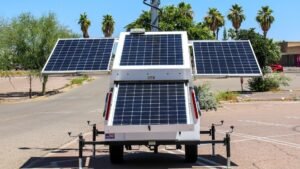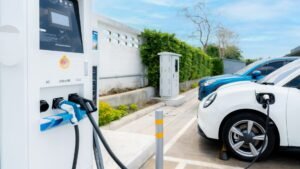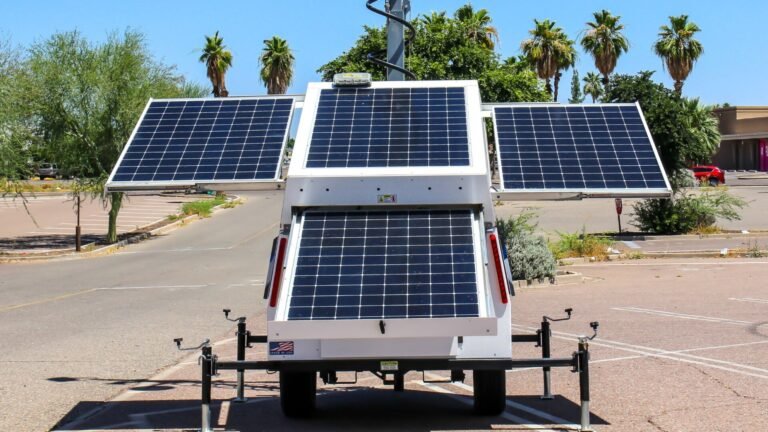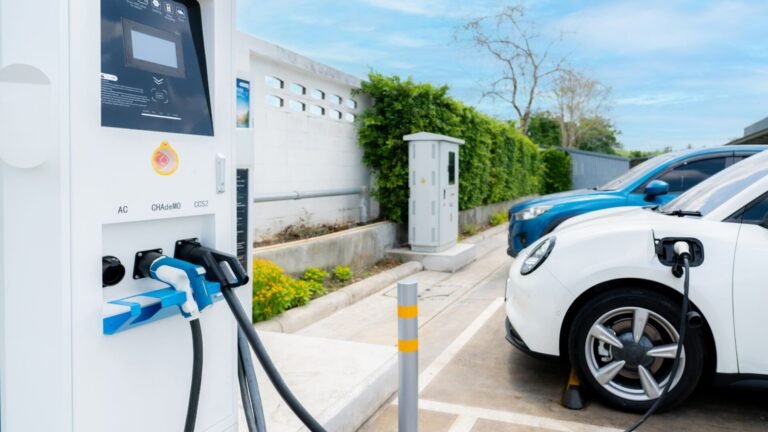In an era where sustainability is not just a choice but a necessity, the emergence of floating solar farms presents a novel and eco-friendly approach to energy generation.
These innovative systems, set atop bodies of water, represent a harmonious blend of renewable energy technology and environmental conservation. As global energy demands continue to rise, the adoption of such sustainable solutions becomes imperative.
Floating solar farms, also known as ‘floatovoltaics’, offer a creative use of space and resources, addressing some of the critical challenges faced by traditional energy generation methods. This technology is especially relevant in areas where land is scarce or too valuable to be allocated for energy production.
By tapping into the untapped potential of water bodies, floating solar farms exemplify the innovative strides being made towards a greener future.
In this blog, we will delve into the environmental impacts and benefits of floating solar farms, highlighting their significance in the modern energy landscape and their alignment with the sustainability goals of forward-thinking companies like Tamesol.
5 Environmental Impacts of Floating Solar Farms
- Water Body Alteration: The installation of floating solar farms can lead to significant alterations in the aquatic environment. The large expanses covered by solar panels can change the natural state of the water body, impacting the local flora and fauna.
While these structures are typically installed on man-made reservoirs, the reduction in direct sunlight can affect the photosynthesis rates of aquatic plants and the overall ecosystem dynamics, potentially disrupting the habitats of fish and other aquatic organisms.
Careful planning and ecological assessments are crucial to mitigate these impacts and ensure that the benefits outweigh the environmental costs. - Materials and Construction: The environmental footprint of manufacturing and deploying floating solar panels includes the extraction, transportation, and processing of materials, as well as the potential for pollution during the construction phase.
The sustainability of these farms depends significantly on the materials chosen for floats and anchors and their long-term impact on water quality and aquatic life.
Responsible sourcing and recycling of materials are vital, as well as minimizing disruptions during installation to preserve the aquatic environment and ensure the longevity of the ecosystem. - Thermal Effects: The presence of floating solar panels alters the thermal profile of the water body, potentially leading to cooler surface temperatures.
This change can benefit water quality by reducing the likelihood of algal blooms, but it may also affect thermal stratification and nutrient cycling within the reservoir.
The altered thermal dynamics could have downstream effects on aquatic species, particularly those sensitive to temperature changes.
Continuous monitoring and adaptive management strategies are essential to address any unforeseen ecological consequences. - Underwater Noise and Vibration: The construction and operation of floating solar farms can significantly introduce noise and vibration into tranquil aquatic environments, potentially disrupting the serene underwater world.
These disturbances can adversely affect marine and freshwater wildlife, especially species that depend on sound for essential activities such as navigation, communication, and foraging.
Recent studies have indicated that underwater noise levels can increase by up to 20 decibels near active construction sites of floating solar installations.
The impact on aquatic life varies considerably based on the technology used, the construction methods, and the proximity to sensitive habitats such as breeding grounds or migration paths.
Project developers must conduct comprehensive acoustic impact assessments and engage in robust monitoring practices.
Implementing mitigation strategies, such as timing construction to avoid breeding seasons or employing quieter construction techniques, is crucial to minimize disturbances to aquatic ecosystems.
By addressing these concerns proactively, developers can significantly reduce the environmental footprint of floating solar farms, ensuring a more harmonious coexistence with the underwater world. - Chemical Leaching: The use of floating solar platforms introduces a potential risk of chemical leaching into aquatic environments, a concern not to be taken lightly.
Particularly when low-quality materials are used, there’s an increased likelihood of hazardous substances seeping into the water, leading to contamination that could adversely affect both aquatic ecosystems and human health.
This risk is of particular concern in reservoirs designated for drinking water, where the implications of contamination are direct and far-reaching. Recent research indicates that certain types of plastics and coatings used in these platforms may release harmful compounds over time, especially under the sun’s intense radiation and varying weather conditions.
To combat this, the adoption of non-toxic and durable materials in the construction of floating solar arrays is essential. Materials should be selected based on their resistance to degradation and their minimal environmental impact, ensuring they do not introduce harmful substances into the water.
Additionally, implementing a regimen of regular water quality monitoring is crucial. This should include comprehensive testing for potential contaminants directly associated with the floating solar infrastructure.
By maintaining vigilant oversight and employing best practices in materials selection, developers can significantly mitigate the risks associated with chemical leaching.
Ensuring that floating solar farms remain a safe and sustainable energy solution requires an ongoing commitment to environmental safety standards and proactive measures to prevent contamination.
By adhering to these principles, floating solar projects can provide clean energy while preserving the integrity and health of aquatic ecosystems and safeguarding public health.
Environmental Benefits of Floating Solar Farms
- Land Preservation: Floating solar farms are pivotal in land conservation, offering a sustainable and innovative alternative by harnessing underutilized water bodies for energy production.
This approach is exceptionally advantageous in regions where land is scarce, highly valued, or under environmental protection.
In densely populated countries like Japan and the Netherlands, where available land is at a premium, floating solar technology has been adopted extensively to meet renewable energy targets without compromising valuable terrestrial habitats.
The Kagoshima Nanatsujima Mega Solar Power Plant in Japan is a stellar example, conserving precious land by spanning over water, thus saving acres traditionally used for agriculture or development.
This plant not only generates around 70 MW of clean energy but also exemplifies the strategic use of space in land-scarce regions. Similarly, in the Netherlands, floating solar projects capitalize on the country’s abundant water bodies to produce energy without encroaching on limited land resources.
By transitioning to these aquatic platforms, floating solar farms not only mitigate land use conflicts but also contribute to preserving ecosystems and maintaining biodiversity, establishing a sustainable coexistence between renewable energy production and land conservation.
This strategic allocation of resources underscores a global shift towards more adaptive and environmentally sensitive energy solutions, reflecting a commitment to preserving our natural landscape while addressing the growing demands for renewable energy. - Water Conservation: The strategic placement of floating solar panels on reservoirs and lakes plays a significant role in mitigating water evaporation, a critical benefit in regions facing water scarcity and drought conditions.
Research indicates that large-scale floating solar farms can lead to a reduction in water evaporation by up to 70% in the areas they cover, preserving precious water resources for agricultural, domestic, and ecological needs.
For instance, the floating solar project on the Banasura Sagar reservoir in India, which spans an area of 1.25 acres, has been instrumental in conserving water, with estimations suggesting it helps save approximately 9 million liters of water annually.
This conservation is critical during periods of low rainfall, ensuring sustained water availability for surrounding communities and ecosystems.
In drought-prone areas, such as parts of California and Australia, floating solar installations could provide dual benefits of renewable energy production and significant water savings, enhancing local water security and supporting agricultural activities.
By reducing the evaporative loss from water bodies, floating solar systems offer a sustainable solution, contributing to the efficient management of hydrological resources while generating clean energy.
This innovative approach underscores the multifaceted value of floating solar technology, making it an increasingly popular choice for regions worldwide striving to balance energy needs with water conservation imperatives. - Energy Efficiency: The unique advantage of floating solar panels lies in the cooling effect provided by the water bodies beneath them, which significantly enhances their operational efficiency.
Land-based solar systems often experience efficiency losses when temperatures rise, but floating solar arrays remain cooler, maintaining closer to optimal performance levels.
This natural cooling mechanism can increase the energy output of floating solar panels by up to 10% compared to their ground-mounted counterparts, as demonstrated in various studies and real-world applications.
For example, a project in Singapore’s Tengeh Reservoir reported that its floating solar system was consistently more efficient than similar land systems, especially during peak sunlight hours.
This increase in efficiency leads to a higher annual energy yield, translating into more electricity generated per square meter of solar panel.
This not only maximizes the energy production from each panel but also leverages the synergy between water conservation and energy generation, making floating solar farms a paragon of sustainable energy solutions.
By optimizing the use of natural resources, floating solar technology represents a significant advancement in the pursuit of more efficient and environmentally friendly renewable energy systems.
This heightened efficiency is a compelling reason for the energy sector to adopt floating solar solutions, particularly in regions where land is scarce and water bodies are abundant. - Ecosystem Benefits: The ecological advantages of floating solar farms are multifaceted, extending well beyond the realm of clean energy production.
The shade cast by the floating panels plays a crucial role in moderating water temperatures and reducing light penetration, creating conditions less favorable for harmful algae blooms.
This ecological benefit was notably demonstrated in the case of the Queen Elizabeth II Reservoir in the UK, where the deployment of a floating solar array led to noticeable improvements in water quality.
The installation, covering about 6% of the reservoir surface, has been instrumental in reducing algae growth, thereby minimizing the ecological disruptions often associated with such blooms.
This reduction in algae not only improves the habitat for aquatic life but also decreases the reliance on chemical treatments, which can have their own adverse environmental impacts.
Furthermore, studies have shown that in areas with floating solar installations, there can be a significant reduction in the chemical and biological oxygen demand levels in the water, leading to healthier aquatic ecosystems.
By mitigating the factors that contribute to excessive algae growth, floating solar farms promote a more balanced aquatic ecosystem, contributing to the preservation and enhancement of biodiversity in freshwater environments.
This sustainable approach to energy generation showcases how renewable technologies can be harmoniously integrated with nature, leading to positive outcomes for both energy and environmental management. - Reduced Greenhouse Gas Emissions: Floating solar farms play a pivotal role in the global effort to combat climate change, significantly reducing greenhouse gas emissions by substituting fossil fuel-derived electricity with clean, solar-generated power.
The environmental impact of these installations is profound; a standard 1 MW floating solar plant is capable of reducing carbon emissions by approximately 1,000 tons each year.
This figure is particularly impactful when considering larger installations worldwide. For instance, the 150 MW floating solar farm in Anhui, China, one of the world’s largest, is estimated to reduce carbon emissions by up to 150,000 tons annually.
This substantial decrease in greenhouse gases is instrumental in moving toward global carbon neutrality objectives, aligning with international agreements such as the Paris Accord.
By integrating floating solar technology into the energy mix, countries can make significant strides in reducing their carbon footprint and mitigating the adverse effects of climate change.
This shift not only contributes to a cleaner, more sustainable energy future but also demonstrates the critical role that innovative solar technologies like floating solar farms play in achieving environmental and sustainability goals on a global scale.
Conclusion
Floating solar farms present a promising path forward in the quest for sustainable energy solutions, offering a series of environmental benefits that align with global conservation goals.
However, understanding and mitigating their environmental impacts is crucial to ensuring that these innovative systems contribute positively to our ecosystems and overall environmental health.
As Tamesol continues to explore the potential of floating solar technology, it does so with a commitment to environmental stewardship and sustainable development.
By championing responsible practices and pushing for advancements in solar energy, Tamesol is not only contributing to a greener planet but also inspiring a new wave of ecological innovation in the solar industry.
The journey towards a sustainable energy future is complex, but with careful consideration and innovative approaches like floating solar farms, we can achieve a harmonious balance between fulfilling our energy needs and preserving our natural world.






